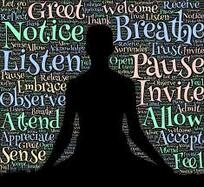 I know that the word “mindfulness” has become a bit of a buzzword over the last couple years, however, there really are some amazing benefits having a mindfulness practice can provide. But first, what do I mean by a mindfulness practice? What even is Mindfulness? According to Jon Kabat-Zinn, the creator of Mindfulness Based Stress Reduction (an evidence-based mindfulness practice), “mindfulness means paying attention in a particular way, on purpose, in the present moment, and nonjudgmentally”. Basically, if you are paying attention to one thing as you do it, then you are being mindful! This can seem like a wild idea when we think about how highly valued being a “multi-tasker” is in our society these days! Many people associate mindfulness with meditation. Mindfulness meditation does exist, however, you can be mindful while going about everyday activities as well such as washing the dishes, eating, or exercising. Whenever I mention meditation to people, I often get some version of this response: “I’m not any good at meditating because I can’t keep my mind clear of all thoughts”. And I’m here to tell you that having a totally empty mind is not the meditation/mindfulness practice! The practice is returning to your focus. It’s perfectly natural for thoughts, emotions, and sensations to arise while practicing mindfulness or meditation. That’s kind of what your brain was designed to do! The practice is to avoid getting attached to those thoughts, feelings, or sensations and instead acknowledge that they exist and return your mindful attention back to your object of focus. What do I mean by “object of focus”? It can be anything! In many cases, especially for beginners, the object of focus is the breath. The breath is a great focus for mindful or meditation practices because it is something we all have and it is a present-moment activity. We don’t breathe from the past or into the future – we breathe right now. When you are mindfully breathing, you are focusing on the sensation of breathing and that’s it. In its most basic form, you are not changing anything about the breath, you are just following it in and out of your lungs while you try to focus on the various sensations that accompany the act of breathing. The feel of the cool air across your upper lip as it enters your nose; the feeling of cool air hitting the back of your throat; the feeling of your lungs beginning to expand as they fill with air; the expansion of the belly or rise of the chest; the slight tension between the in and out breath; the relaxation of the belly or fall of the chest; the contraction of the lungs as the air leaves; the warm air over your upper lip as it exits your nose; and the slight pause in between the out breath and the next in breath before repeating the cycle. Repeat.  As you do this, it is normal to get distracted. Those distractions may be thoughts (for example: “I need to remember to buy bread and cat food at the store later”) or feelings (for example: “I am feeling anxious in my chest right now”) or sensations (for example: “my legs are feeling a bit cramped from sitting still for this long”). The trick is to learn to recognize that something has come up, not attach to it, let it go, and return to the breath. One way of letting it go is to use what I call the “labeling technique” in which label the activity that has distracted you. To do this, you say to yourself “I am thinking” or “I am feeling” or “I am hearing” and then return to your breath; it may even be helpful to say to yourself “and now I return to my breath”. As you become more experienced with this simple technique, you can begin to build upon the practice by changing the way you breathe such as deep belly breathing (also known as diaphragmatic breathing. Place a hand on the belly and feel your belly expand on the in breathe and retract towards your spine on the out breathe) or by counting the in and out breaths (for example: breathing in through the nose for a count of 4, holding the breath for a count of 7, and exhaling for a count of 8 through pursed lips). Other ways to practice mindfulness is to focus solely on the activity you are engaging in. For example, you can make your bed mindfully. As you perform each step, be thinking about and noticing the movements you are making, the actions you are taking, and if thoughts or feelings or other sensations arise – simply label them and come back to the activity. Basically, any time you bring your attention fully to the activity you are engaged in, you are practicing mindfulness. You probably do it throughout your day for moments at a time and don’t even realize it. There are many different ways to practice meditation and mindfulness but that goes beyond the scope of this writing. In closing I want to leave you with the many benefits practicing mindfulness can bring to your life. Mindfulness practices can help with anxiety and stress. One of the things about anxiety is that it often triggers our fight-or-flight mode -which is housed in a part of our brain called the amygdala. This part of the brain is primarily concerned with emotions and instincts and is pretty old, and when it’s in charge, we aren’t able to really access all the other parts of our brain. Our sympathetic nervous system is activated and we’re ready to take action. However, when we begin our mindful practice such as deep breathing, we begin to activate the parasympathetic nervous system. As we exhale, especially if we really focus on the breath and make the exhale longer than our inhale, signals travel to our brain via the vagus nerve telling our brains that it is time to relax. This is the part of our body involved in the ‘rest & digest’ side of things – slowing us down and bringing a sense of calm relaxation. As we move out of fight-or-flight, we begin to activate the frontal cortex of our brain and move into the part of our brain that is involved with executive functions such as planning and decision making and is associated with a sense of well-being. Mindfulness practices have also been shown to reduce hypertension (high blood pressure), improve sleep, and change one’s relationship with pain. Mindfulness can also help people reduce rumination (when you get “stuck” on a thought/feeling), boost working memory (the kind needed for reasoning, decision making, and holding information for a current task), improves focus and concentration, helps individuals be more cognitively flexible and less emotionally reactive. (Here is a great short article from the American Psychological Association on the same topic with references to all the scientific studies) I hope you’ve found this information to be helpful. I have had my own mindfulness practice for about 10 years and I know I can tell the difference when I am practicing regularly and when I let my practice slip. Do you have a mindfulness practice? Are you trying to get started? Let me know in the comments. I plan to write more on this topic in coming blogs. Thanks for reading, Kristie |
AuthorKristie Fuller is a Registered Mental Health Counselor Intern working towards full licensure in Florida. Archives
November 2019
Categories |
 RSS Feed
RSS Feed
